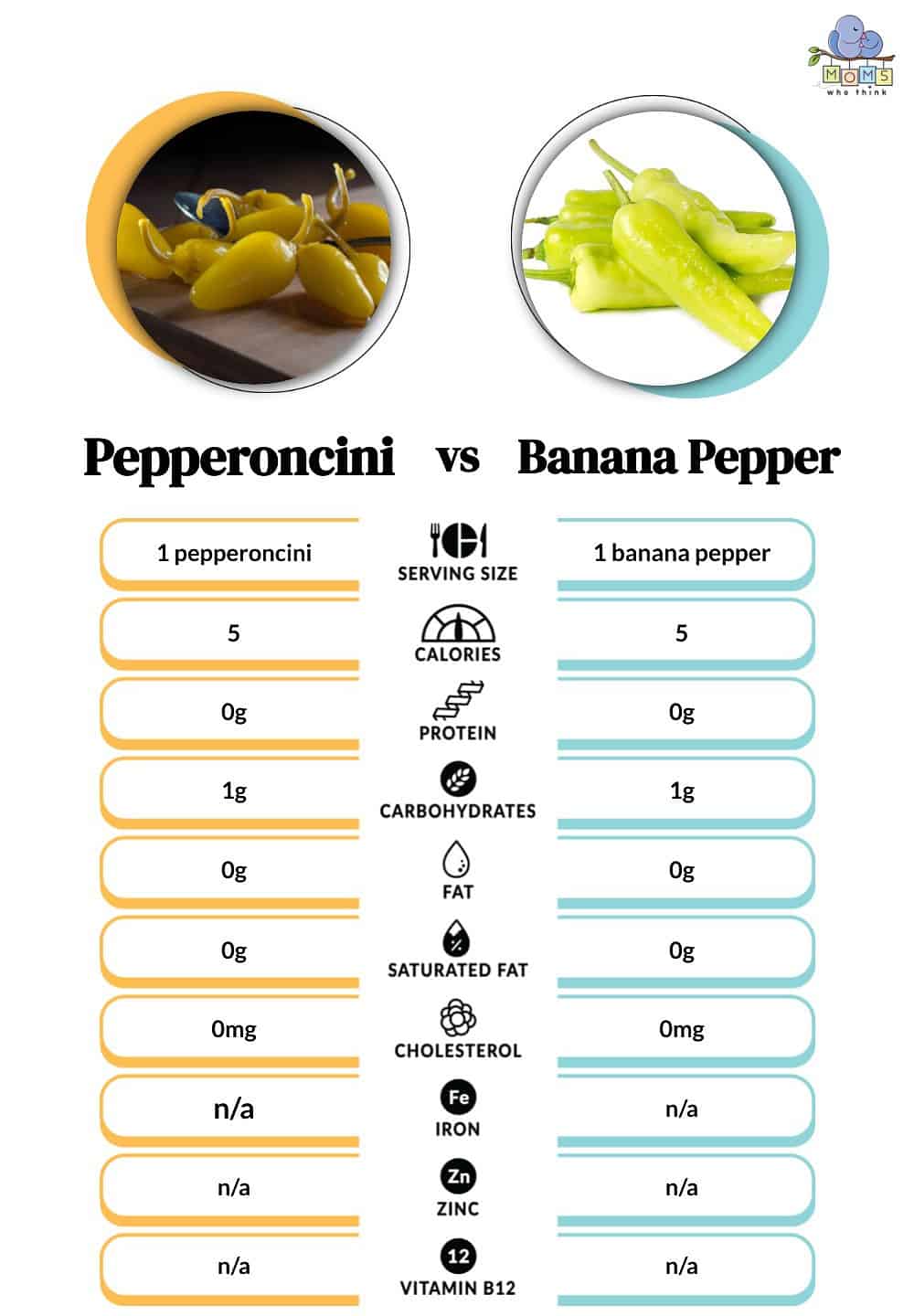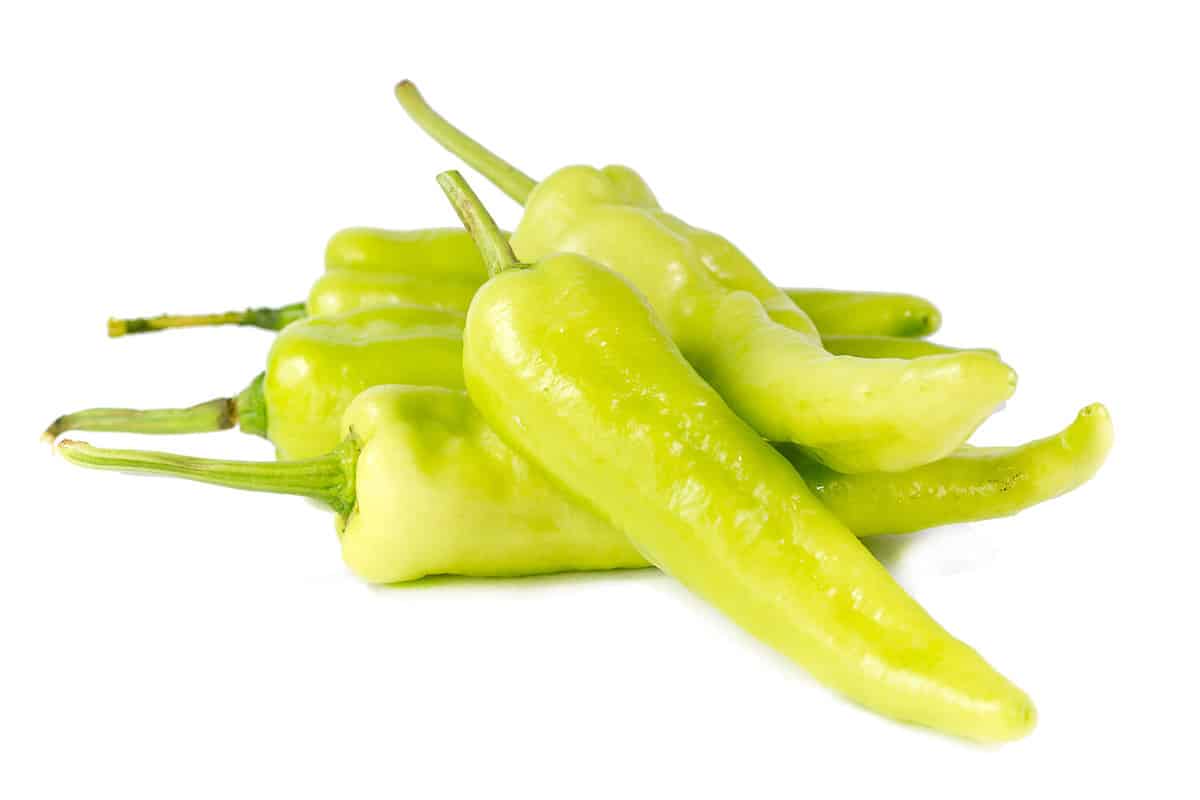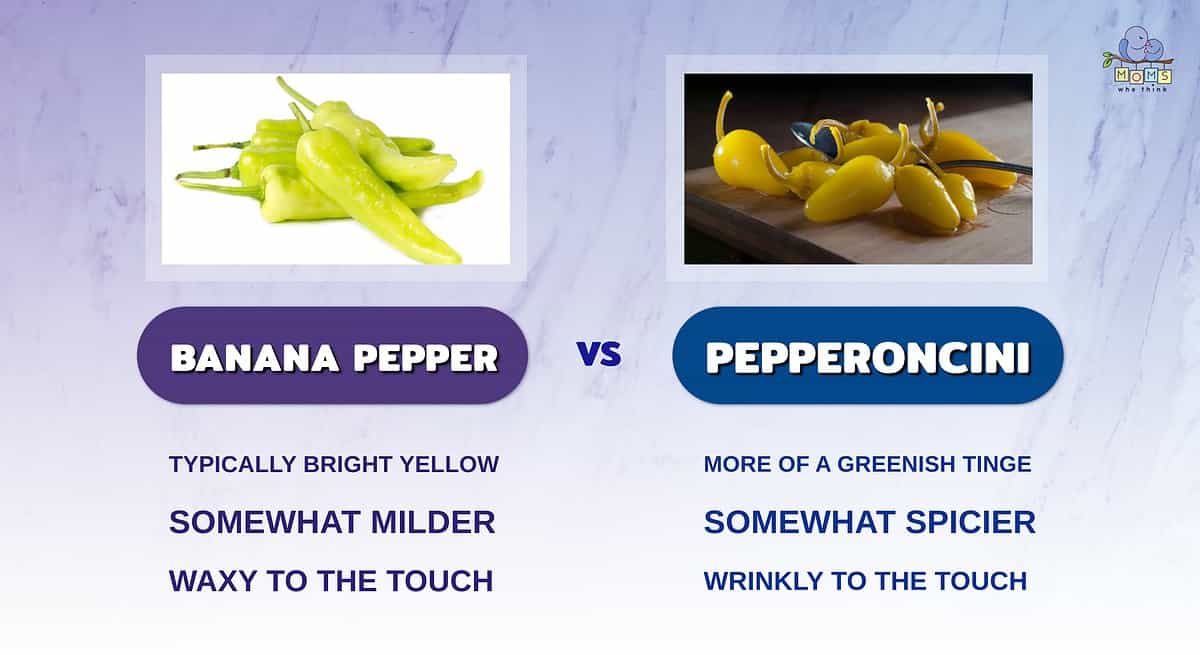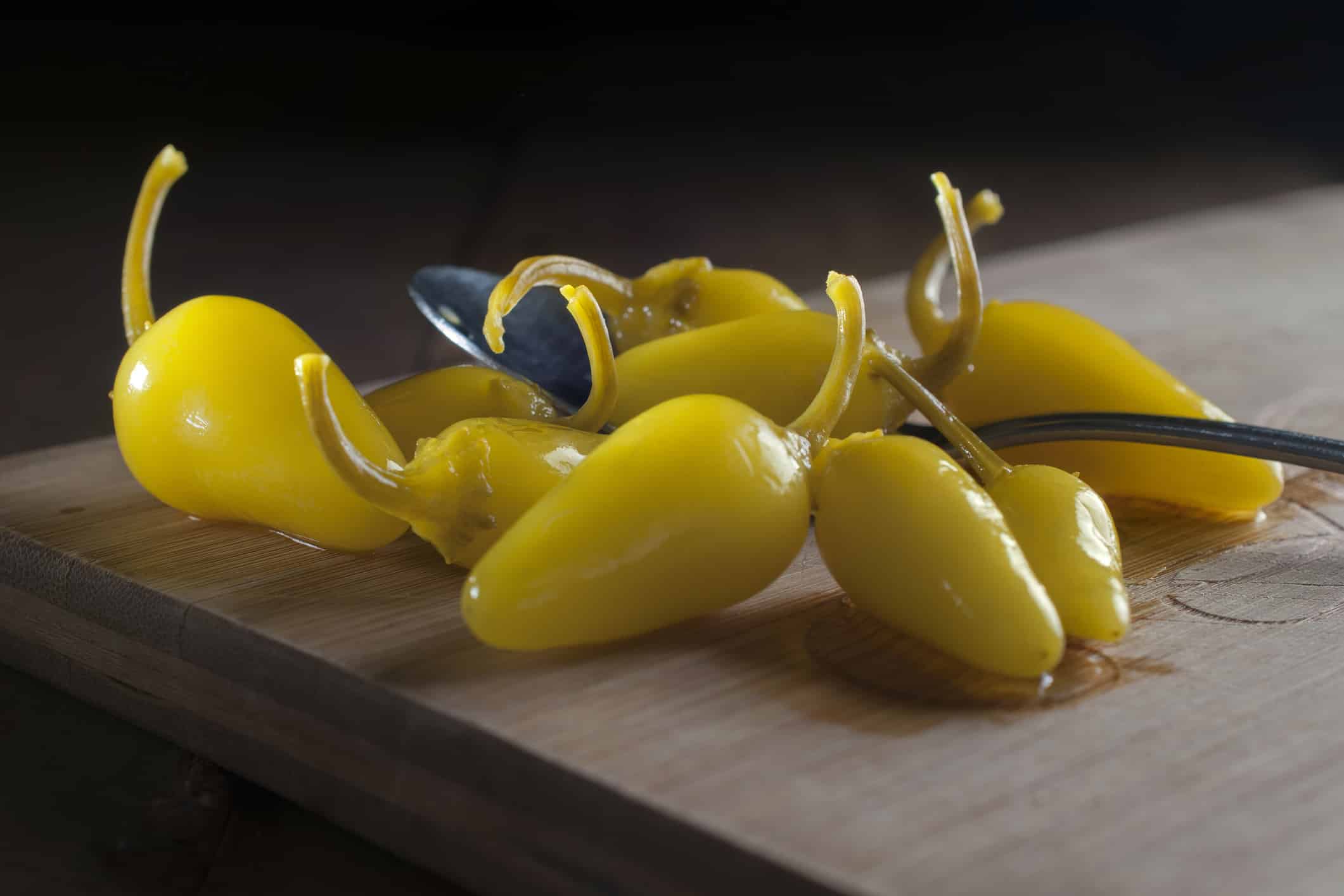Are you wondering about the difference between Banana pepper vs. Pepperoncini? You might mistake these two types of peppers upon first look. However, upon closer inspection, there are major differences in the coloring, texture, and overall taste. Banana peppers are waxy peppers so named for their resemblance to a banana. They are typically bright yellow in color. Pepperoncini, on the other hand, have a more greenish tinge to them. They also have wrinkled skin and a slightly higher spice level in terms of their taste profile. Both are staples of pickled pepper options, but they are unique in their own ways and should be picked accordingly.
Keep on reading to learn some of the history of each of these pepper types as well as some of the popular uses. We’ll talk about preparation options in different recipes and the nutritional profile of each pepper type. At the end of this post, you will for sure know the difference between Banana pepper vs. Pepperoncini pepper types. Feel confident with your choice and include them in your favorite recipes going forward. Let’s get into the details and the differences.
Banana Pepper vs. Pepperoncini: How Are They Different?
There are three main areas in which Banana pepper vs. Pepperoncini truly differ. These differences stand out in coloration, texture, and taste. Banana peppers resemble their namesake, with smooth skin and a mild taste with little to no spice. Pepperoncini have a more greenish skin that often appears quite wrinkly, with the pepper itself appearing slightly curled. In terms of heat, Pepperoncini has a slight tang in comparison to Banana Pepper, which results in a higher heat rating in terms of flavoring.

©
What Are Banana Peppers?
Banana peppers are medium in size, with smooth skin, and a mild, bright taste. They are typically yellow but can mature to colors of red, green, and yellow. In terms of the classical meter for spice level, the Schoville Heat Unit (SHU) of the Banana pepper clocks between 0-500 SHU. The Scoville Scale measures the amount of capsaicin, which is the compound that causes tastebuds to respond to spicy heat. The number assigned has to do with how many times a pepper's solution would need to be diluted to neutralize the heat. So a Banana pepper would need to be diluted very little (via Master Class).
- The must-have convenient reference guide for every home cook!
- Includes more than 8,000 substitutions for ingredients, cookware, and techniques.
- Save time and money on by avoiding trips to grab that "missing" ingredient you don't really need.
History and Origin Of Banana Peppers
Banana peppers descended from a breed of Hungarian pepper that entered the States around 1932. It was the Corneli Seed Company that modified the seeds to be sweeter. And that is the breed that we know as the modern Banana pepper. The current Banana pepper has a sweet taste, especially compared to it much spicier Hungarian ancestor (via Specialty Produce).
Uses For Banana Peppers
Try Banana peppers pickled, stuffed, or deep-fried. Put them in salsa, as a side for deli products, or in sandwiches themselves. Pickling Banana peppers is quite simple. According to Food And Wine Magazine, it can take only 20 minutes to prepare for pickling!
To start, you'll need to prepare the brine you'll need water, salt, sugar, and vinegar. Bring that mixture to a boil in a saucepan. Once the salt and sugar are dissolved completely, let it cool. Slice your fresh Banana pepper into thin strips. Fill up a mason or canning jar to which you will add your brine solution. Pour enough solution to be about an inch from the top. You have the option to put a smashed garlic clove at the top for increased flavoring. Allow the brine to cool completely before putting your lid on it. Refrigerate for at least 24 hours before eating. The longer you wait, the more pickled they'll be, however, you should not wait longer than 3 months.

©Kentaro Foto/Shutterstock.com
What Are Pepperoncini?
Pepperoncini are a variety of sweet pepper that has greenish, yellow skin with a wrinkled appearance to it. In its mature form, the pepper may appear red. The coloring doesn't impact its heat level which rates between 100-500 SHU. This is a much lower heat level than the pepper they were adapted from. The Hungarian Wax pepper clocked in between 1,000 and 15,000 Scoville Heat Units.
History And Origin of Pepperoncini
Pepperoncini is one of many names given to these sweet, spicy peppers. Other names include peperone, Tuscan pepper, golden Greek pepper, sweet Italian pepper, and friggitello pepper. The reason they have so many names is because they are grown in areas across the Mediterranean, and Europe as well as in parts of Central and South America. This pepper type was originally brought into Europe via Spanish explorers, and they didn't catch on in Italy until it could be proven this pepper was edible (via Dellalo).
Uses For Pepperoncini
Like Banana peppers, try your Pepperoncini pickled, in sandwiches, salads, or for snacking. Stuff them with ingredients like cream cheese, bacon, and other kinds of meat. They also make a great side to many deli dishes. Pepperoncini peppers are a great addition of flavor to lots of recipes, just let inspiration lead you and give these peppers a try!
Nutritional Value
The brand you pick may determine the nutritional profile of the pickled pepper. Try saying that sentence five times! Anyway, WebMD actually recommends Banana Peppers as a fantastic source of vitamin B6 which helps your body produce dopamine and serotonin.
A cup of Banana peppers have about 33 calories, 2 grams of protein, 7 grams of carbohydrates, 2 grams of sugar, and 1 gram of fat. Because it's high in fiber and low in calories, Banana peppers can be a great source of fiber without the added calories. They have high levels of vitamins A, C, and K, as well as minerals like potassium, calcium, and folate.
As for Peperoncini, a little over a cup of results in about 30 calories, 0.1 grams of total fat, 7.4 grams of carbohydrates, 1.9 grams of dietary fiber, 1.3 grams of protein, and 4.6 grams of sugar. If you were to pickle either of these peppers, the sodium and sugar content would likely go up.
Possible Alternatives To Banana Peppers And/Or Pepperoncini
Other sweet pepper types can provide a similar flavor if you don't have Banana peppers or Pepperoncini handy. Try out Cherry peppers, Anaheim peppers, Poblano peppers, Jalapeno peppers, or Cubanelle peppers. The hottest of these will be the Jalapeno, which falls between 2,000-8,000 SHU. The others are mostly sweet or wouldn't score much higher than a Pepperoncini pepper. If you want to test your taste buds against some truly hot peppers, you could try the Banana pepper's ancestor, the Hungarian Wax Pepper, or some of the world's spiciest peppers! These include the Carolina Reaper (2,200,000 SHU), the Trinidad Moruga Scorpion and Butch peppers, (2,009,231 SHU and 1,463,700 SHU), and the Naga Viper pepper (1,382,118 SHU). Good luck, and take care with those spicier suggestions!
Are These Peppers The Same Thing?

- Banana peppers are named as they are because they're similar in color to bananas. Pepperoncini has more of a greenish tinge to it, distinguishing it fairly easily from banana peppers.
- While both of these peppers are considered to be on the milder end of the heat scale, pepperoncini is somewhat spicier than banana peppers. This is important to keep in mind if you or someone in your family is extra sensitive to spice.
- Banana peppers tend to be waxy and smooth to the touch, while pepperoncini has more of a wrinkly feel to it.
The short answer is no, they are not the same thing. Banana peppers and Pepperoncini are two different types of peppers that, aside from different names, also have differing tastes, colors, and overall appearances. Banana peppers are bright yellow, smooth, and milder in taste. Pepperoncini peppers can have a greenish tinge, a bit more tang, and wrinkly skin. They are both sweet peppers in use and are delicious when pickled, stuffed, or used as a garnish, but they are two different things.
- The must-have convenient reference guide for every home cook!
- Includes more than 8,000 substitutions for ingredients, cookware, and techniques.
- Save time and money on by avoiding trips to grab that "missing" ingredient you don't really need.
Still looking for a dish to use pepperoncini in? Check out this recipe for Italian Beef, which uses a jar of Pepperoncini peppers as well as the juice from them to flavor the meat.
PrintItalian Beef with Pepperoncini
Ingredients
3 pound beef chuck roast
1 onion, quartered
1 teaspoon salt
1/2 teaspoon pepper
1 (14 ounce) can beef broth
1 package Good Seasons Italian salad dressing
1 envelope dry Au Jus mix
1/2 jar Pepperoncini Peppers and juice (from 16 oz jar)
Hamburger buns for serving
Instructions
1. Place meat and onion in crock pot.
2. Mix together salt, pepper, broth, salad dressing, and Au Jus mix in a medium bowl. Pour over meat.
3. Add peppers and juice.
4. Cover and cook on low for 6 to 7 hours.
5. Remove meat from crock pot and slice or shred.
6. Place meat, peppers, and onions on hamburger bun or slice of bread for open faced sandwiches.
7. Ladle juice over top.
The image featured at the top of this post is ©iStock.com/Victor Yee.
- The must-have convenient reference guide for every home cook!
- Includes more than 8,000 substitutions for ingredients, cookware, and techniques.
- Save time and money on by avoiding trips to grab that "missing" ingredient you don't really need.


